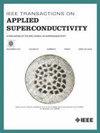Electromagnetic and Cryogenic Conceptual Design of a 20 MW LTS Superconducting Wind Generator
IF 1.7
3区 物理与天体物理
Q3 ENGINEERING, ELECTRICAL & ELECTRONIC
引用次数: 0
Abstract
Offshore wind power is trending towards larger capacities and deep-water applications. To accommodate floating platforms in deep water and to avoid reliability issues related to gearboxes, it is essential to enhance the power density of direct-drive wind generators thereby reducing their weight and volume. This paper presents a conceptual design for a 20 MW low-temperature superconducting (LTS) wind generator. A thermosiphon helium piping cooling system, which rotates with the LTS excitation coils as the rotor, is proposed to keep the coils at 4.2 K by circulating helium through gravitational force while rotating without any pump. Using NbTi wires for the excitation coils, the designed sample generator features a radial magnetic flux density of 3 T in the air gap at a rated speed of 10 rpm. The rated voltage and current are 3300 V and 3500 A respectively. By a 2D finite element model, the basic electromagnetic structure is designed that has an air gap diameter of 6 m, an axial length of 1.1 m with 48 poles and 576 slots. The maximum magnetic field of 4.3 T locates inside the NbTi excitation coils. The cryogenic cooling system employs 8 cryostats, each containing six NbTi coils with a carbon fiber reinforced plastic suspension system and a GM cryocooler. The estimated heat leaks for a single cryostat are 0.382 W at 4.2 K and 39.8 W at 50 K.求助全文
约1分钟内获得全文
求助全文
来源期刊

IEEE Transactions on Applied Superconductivity
工程技术-工程:电子与电气
CiteScore
3.50
自引率
33.30%
发文量
650
审稿时长
2.3 months
期刊介绍:
IEEE Transactions on Applied Superconductivity (TAS) contains articles on the applications of superconductivity and other relevant technology. Electronic applications include analog and digital circuits employing thin films and active devices such as Josephson junctions. Large scale applications include magnets for power applications such as motors and generators, for magnetic resonance, for accelerators, and cable applications such as power transmission.
 求助内容:
求助内容: 应助结果提醒方式:
应助结果提醒方式:


